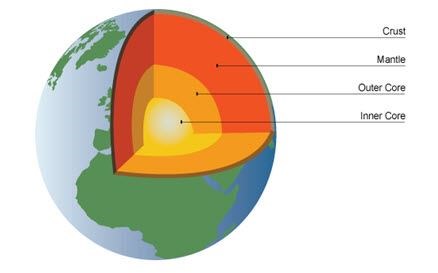
The oil business is very complex, and organizations struggle to uncover hidden oil resources beneath the earth’s surface so they can be profitably exploited for business purposes. The primary challenge for these organizations is to understand the key characteristics of the earth so that oil and gas reserves can be recovered.
A sound understanding is essential for the geological engineers who help organizations in their mission to extract oil from the earth. Let us briefly examine these earth matters, such as what the formations are, where the oil reserves are present and the different types of rocks that are relevant to understand the oil reserves beneath the earth’s surface.
Please click on the link to buy caustic soda flake
The Earth – A Giant Onion
The earth consists of different layers such as the crust, upper mantle, mantle, outer core and inner core. The crust is the topmost part of the earth and it is the thinnest layer under the seabed. It consists of solid rocks mostly with silicon and oxygen. The upper mantle and mantle are the thickest parts of the earth and together they form the middle layer of the earth. Though they are the heaviest, they are composed of hot soft rocks containing iron and magnesium. As the depth increases, the density of this layer also increases. The final portion of the earth consists of the outer core and inner core with the heaviest layer and densest substances containing iron and nickel. From an oil and gas perspective, only the topmost layer of the earth, the crust, is important and relevant for finding oil reserves.
Oil as a Nuisance Value
Oil and gas are resources naturally present on the earth. In the early days, human beings did not recognize these resources to be useful. There were instances when petroleum seeped out onto the surface, which were considered spoiled areas because petroleum polluted the soil and water. This was a big challenge for the inhabitants to handle and they contained the seepages by mobilizing huge quantities of sand and other materials. Hence, there were times when petroleum was considered a nuisance by society.
This changed dramatically when people discovered how useful petroleum was – first as a fuel for lamps to bring light to homes and cities and later for energy generation. It became even more important after the industry developed more and more products that were based on oil. Soon, oil and gas turned into resources that are intensely sought after. More exploration activities commenced and oil reserves were rapidly depleted. Only in very rare cases do oil and gas appear naturally on the surface; most often oil and gas is hidden deep below thick layers of rock. To discover the resources, engineers must have a profound knowledge of the earth and expend a lot of effort in research.
Oil Play – Where are the Oil Reserves Hidden?
As petroleum resources have become a premium content, more effort and expert knowledge have led to a clear understanding of where the oil reserves are exactly located. As stated earlier, oil reserves are found in the topmost layer of the earth called the crust. Only up to 10 kilometers of the upper crust area is suitable for the oil to exist in a stable condition for a long period of time. Beyond that point, the atmosphere becomes too hot for oil to sustain and it starts to decay and it is not suitable for use or extraction.
It is interesting to know the processes that work together to generate oil and gas and the prerequisites for a reservoir where oil and gas can accumulate in an amount that is feasible to exploit. (Learn more about this topic in How Hydrocarbon Reservoirs Are Formed: The Rock Cycle.) It must make economic sense to recover the oil from the reserves because doing so entails huge investments.
To understand the petroleum play concept, we need to gain full comprehension of a few key terms such as cap rock, source rock, reservoir rock, trap and migration. Oil and gas reserves are very mobile because they are very light as compared to other rock formulations. Hence, they move up striving to reach the surface of the earth. If the content is in gaseous form and this movement is not halted then it reaches the surface and escapes into the atmosphere. In the case of liquid substances, it will pool on the ground until it biodegrades. If stopped by a rock formation due a lack of permeability, then the oil reserves begin moving laterally to a point where they find a spot through which they can travel upward. (Rock permeability is examined in the article Grasping the Concept of Rock Permeability.) This impermeable rock formation is called cap rock.
A source rock is the origin where hydrocarbons are produced or generated. They are basically organic shale layers where hydrocarbons are emitted due to high pressures and temperatures. The nature of these source rocks is highly porous and permeable. The source rock formations are interconnected and hence the petroleum reserves can easily travel through them.
The rock formations sandwiched between the cap rock and source rocks are called reservoir rocks, and this is where large quantities of hydrocarbons are trapped. After expulsions from the source rocks, hydrocarbons flow into the reservoir rocks and this process is called migration. A trap is a favorable situation where the hydrocarbons are stored between the source and cap rocks. It is interesting to note that if any of these factors does not exist, then the accumulation of hydrocarbon reserves does not happen. Eventually the oil reserves would reach the earth’s surface only to vanish into thin air or degrade themselves to be buried into the earth to start a new cycle of hydrocarbon formation.
Complex Area that Requires Expertise
What we discussed in this article is the tip of the iceberg regarding the characteristics of earth formulations that lead to petroleum accumulation. Specialized knowledge and experience is required to correctly interpret the earth’s surface in a way that will lead to discovering a hydrocarbon presence. The reservoir rock may be far away from the traces of hydrocarbons seen on the earth’s surface. The idea is to get to the core of the reservoir rocks where the treasure of black gold lies.
